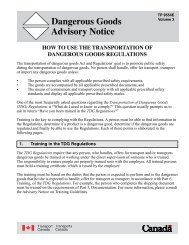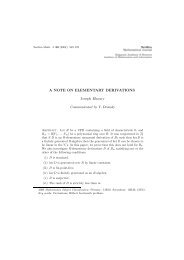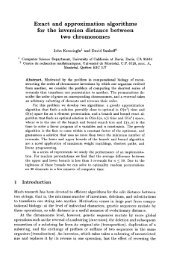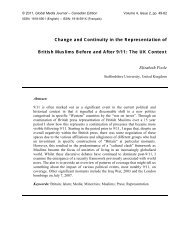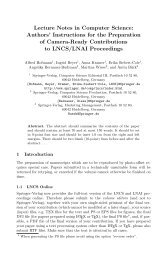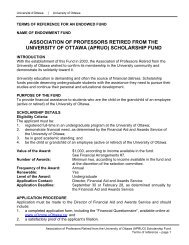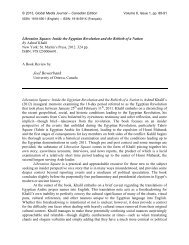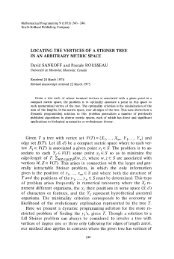Feminist Approaches to Journalism Studies: Canadian Perspectives
Feminist Approaches to Journalism Studies: Canadian Perspectives
Feminist Approaches to Journalism Studies: Canadian Perspectives
You also want an ePaper? Increase the reach of your titles
YUMPU automatically turns print PDFs into web optimized ePapers that Google loves.
© 2008, Global Media Journal -- <strong>Canadian</strong> Edition<br />
ISSN: 1918-5901 (English) -- ISSN: 1918-591X (Français)<br />
Volume 1, Issue 1, pp. 123-136<br />
<strong>Feminist</strong> <strong>Approaches</strong> <strong>to</strong> <strong>Journalism</strong> <strong>Studies</strong>:<br />
<strong>Canadian</strong> <strong>Perspectives</strong><br />
Gertrude J. Robinson<br />
McGill University, Canada<br />
Abstract:<br />
One of the orthodoxies of communication scholarship is that much of the genderbased<br />
differences between males and females with regard <strong>to</strong> experiences in<br />
newsrooms can be attributed <strong>to</strong> demographics. The discussion presented in this<br />
paper challenges this claim by comparing the findings of two national surveys that<br />
measured the professional progress of <strong>Canadian</strong> press and television journalists.<br />
The first survey was undertaken in 1975, and the second in 1995. While the<br />
his<strong>to</strong>rical evidence points <strong>to</strong> reductions in gender-based structural inequalities<br />
over time, it also identifies the continued presence of gender-based assumptions<br />
about how work and family obligations should be combined. Such assumptions, it<br />
is argued, help <strong>to</strong> foster and reproduce systemic biases in the newsroom culture<br />
that still resonate <strong>to</strong>day in the journalism profession and which can be best<br />
unders<strong>to</strong>od as a manifestation of the meaning of gender at three levels: as a<br />
classifying system, as a structuring structure, and as an ideology.<br />
Keywords: Gender; <strong>Canadian</strong> Press; <strong>Canadian</strong> Television; <strong>Canadian</strong> Journalists;<br />
Inequality; Bias; Ideology
Gertrude J. Robinson 124<br />
Résumé:<br />
Une des orthodoxies de la mission professorale de la communication est que la<br />
grande partie des différences basée sur les genres entre le masculin et le féminin,<br />
en ce qui concerne l’expérience en salle de presse, peut être basée sur la<br />
démographie. Les arguments présentés dans cet article contestent cette orthodoxie<br />
par la comparaison des résultats obtenus lors de deux sondages nationaux qui ont<br />
mesuré la progression professionnelle de la presse canadienne et des journalistes<br />
de la télévision. Le premier sondage a eu lieu en 1975 et le deuxième en 1995. La<br />
preuve his<strong>to</strong>rique démontre une baisse des inégalités structurales basée sur le<br />
genre, cependant elle identifie aussi le maintien de la présence des préjugés basés<br />
sur le genre à propos de la combinaison des obligations du travail et de la famille.<br />
D’après l’auteur, ces préjugés encouragent la reproduction systémique de<br />
partialité qui se trouve dans la salle de presse et qui influence encore la profession<br />
journalistique contemporaine par une manifestation de la définition du genre à<br />
trois niveaux : comme un système de classification, comme une structure de<br />
structuration et comme une idéologie.<br />
Mots-clés: Genre; Presse Canadienne; Télévision Canadienne; <strong>Journalism</strong>e<br />
Canadien; Inégalité; Biais; Idéologie<br />
Introduction<br />
Despite the fact that gender and communication studies have begun <strong>to</strong> demonstrate that<br />
newsroom work is different for female and male personnel, communication scholarship<br />
continues <strong>to</strong> perpetuate the orthodoxy that women’s different experiences in the newsroom are a<br />
result of their lesser numbers. In <strong>Canadian</strong> studies as recent as those of Pritchard and<br />
Sauvageau’s Les journalists Canadiens (1999), gender is considered a biological attribute that<br />
exists in isolation from social characteristics like ethnicity, status, and education. Although this<br />
might have been a persuasive argument in the 1970s, gender studies have indicated that such a<br />
view is not only oversimplified, but factually wrong. News work for women is different because<br />
of systemic biases in the social reproduction of the profession. These systemic biases are<br />
recreated through classifica<strong>to</strong>ry and evaluative procedures that use gender dualisms <strong>to</strong> define<br />
women and ethnic minorities as “different” and then fall back on these classifica<strong>to</strong>ry differences<br />
as reasons for the unequal evaluations of women’s newsroom activities.<br />
In <strong>Canadian</strong> society, as in North America and Europe, these systemic biases are primarily<br />
grounded in gender-based assumptions about how work and family obligations should be<br />
combined. This is demonstrated by the fact that in spite of married women’s increased<br />
employment at the beginning of the 21 st century, their work outside the home has not reduced the<br />
time spent on their family roles, or increased their husband’s family involvement (Armstrong &<br />
Armstrong, 1990). As a consequence, Pleck (1984) notes that employed wives face strain and<br />
exhaustion in combining what he calls their “dual roles”. These gendered work and family role<br />
expectations begin <strong>to</strong> explain the predominance of males in such a prestige profession as
125<br />
<strong>Feminist</strong> <strong>Approaches</strong> <strong>to</strong> <strong>Journalism</strong> <strong>Studies</strong>: <strong>Canadian</strong> <strong>Perspectives</strong><br />
journalism, as well as how differently female and male journalists have <strong>to</strong> organize their working<br />
lives.<br />
A Millennial Portrait of <strong>Canadian</strong> Print Journalists<br />
In order <strong>to</strong> examine these structural issues, comparative national surveys were conducted in 1975<br />
and 1995 <strong>to</strong> measure the professional progress of <strong>Canadian</strong> press and television journalists. They<br />
covered all 114 dailies and 118 television outlets that were in operation at the time. Information<br />
was obtained regarding: female/male participation rates; the organizational positions of females<br />
and males; professional beats and average salary levels. In the two decades between the surveys<br />
structural inequalities resulting from gender classification in <strong>Canadian</strong> journalism substantially<br />
diminished. The comparative evidence indicates that female progress includes more access,<br />
faster progress up the professional ladder, as well as increased pay in the media professions,<br />
fac<strong>to</strong>rs that have also been observed in Europe (Melin-Higgins & Djerf-Pierre, 1998). In daily<br />
newspapers, female access grew from one in five in 1975, <strong>to</strong> about one in three at the turn of the<br />
century. In 1975 females constituted only 21% of the full-time employed <strong>Canadian</strong> print<br />
journalists whereas twenty years later they accounted for 28%. Although female participation in<br />
the print sec<strong>to</strong>r grew much more slowly (7%) than that in broadcasting (17%) during the two<br />
decades, the <strong>to</strong>tal pool of employed females in the two media sec<strong>to</strong>rs doubled from 504 <strong>to</strong> 962 in<br />
dailies and <strong>to</strong> 486 in television (Robinson & Saint-Jean, 1997: 6).<br />
Another indication of the reduction of structural inequalities based on gender is found in<br />
women’s progress up the professional ladder. In 1975 females were disproportionately clustered<br />
(62%) in the bot<strong>to</strong>m positions of Reporter and Star Reporter, while in the nineties they held<br />
parity at the bot<strong>to</strong>m of the job hierarchy. By the turn of the century, moreover, females were<br />
proportionally represented at all job levels. This is indicated by the fact that all five position<br />
descriptions—Reporter, Star Reporter, Desk Heads, Day/Night Edi<strong>to</strong>r, and the Assistant<br />
Managing Edi<strong>to</strong>r positions—had between 22% <strong>to</strong> 30% female representation. Comparisons of<br />
management positions in the U.S. and Canada showed that <strong>Canadian</strong> newspaper women were<br />
ahead of their U.S. sisters in managerial clout, even though they <strong>to</strong>o continued <strong>to</strong> have difficulty<br />
achieving the Publisher position. There were an average of 10% female Edi<strong>to</strong>rs-in Chief in<br />
Canada in all circulation types, versus a miniscule 0.8% in the U.S. The same discrepancies were<br />
found on the other management levels and furthermore demonstrate that circulation affects<br />
promotion differently in the two countries. In Canada, large circulation papers are females’ best<br />
bet, while in the U.S. it is exactly the opposite, small circulation dailies offer the best managerial<br />
chances for female staff. At the second and third managerial levels, <strong>Canadian</strong> females held an<br />
average of one third (27%) of the Edi<strong>to</strong>r and Assistant/ Associate Edi<strong>to</strong>r’s positions. Their U.S.<br />
sisters register only 14% in small circulation dailies, with proportions of less than 1% in the<br />
other two circulation categories. At the third management level, that of Managing Edi<strong>to</strong>rs,<br />
Canada’s female proportion was between 10% and 45% depending on circulation, whereas it<br />
ranged between 13% and 16% in the U.S. (Marzolf, 1993: 11).<br />
Why these variations in the figures? As Epstein (1988) suggests, there is an interplay<br />
between gender, organizational and socio-psychological fac<strong>to</strong>rs in the recruitment <strong>to</strong> <strong>to</strong>p<br />
management which differs from country <strong>to</strong> country. Lűnenborg’s (1997) interviews with<br />
European media professionals elicited heavily gendered responses with regard <strong>to</strong> the lack of<br />
females in management positions. Enlightened Danish and German male managers cited “a lack<br />
of qualified female candidates,” which turns out <strong>to</strong> be a typical male gendered preconception
Gertrude J. Robinson 126<br />
based on presumption rather than on evidence (Lűnenborg, 1997: 172-177). German and Danish<br />
female respondents were closer <strong>to</strong> the mark. They opined that only childless, and unmarried<br />
female journalists could accept a position with a 10-hour long working day (Ibid: 165). All<br />
<strong>to</strong>gether these findings demonstrate that females, who started out as a small minority in the<br />
media professions in the seventies, became numerous enough by 2000 <strong>to</strong> affect organizational<br />
change. In conjunction with these changes, the evidence also demonstrates that the “glass<br />
ceiling” moved up from Assistant Managing Edi<strong>to</strong>r <strong>to</strong> Edi<strong>to</strong>r-in-Chief. Even though only 6<br />
females held this position, Canada was ahead of the U.S., Britain, France and Germany in female<br />
promotion in<strong>to</strong> <strong>to</strong>p print management (Ibid: 148).<br />
A final indication of the weakening of gendered inequalities is found in female<br />
journalists’ growing salary equalities, although parity still eludes them. Our evidence showed<br />
that there were three- <strong>to</strong> four-fold increases in weekly earnings over the quarter century for<br />
female staffers, with male salaries increasing even more steeply. In daily print, average weekly<br />
salaries ranged from $214 <strong>to</strong> $400 depending on circulation in 1975, while they grew <strong>to</strong> between<br />
$687 and $1,560 in 1995. Overall, large (over 100,000) circulation dailies located in Canada’s<br />
largest cities such as Montreal, Toron<strong>to</strong> and Vancouver, paid their staffs double as much as small<br />
(under 50,000) circulation papers. Since 51% of all females worked in large circulation dailies in<br />
1995, versus 14% in medium and 35% in small papers, women’s more competitive salary levels<br />
are partially explained by their employment in metropolitan newspapers. Salary differentials are<br />
furthermore affected by sec<strong>to</strong>rial differences. Pritchard and Sauvageau (1998: 381) indicate that<br />
daily print and TV journalists had the highest average salaries of $58,185 and $58,708<br />
respectively in 1997, while radio and weekly print personnel received substantially less, an<br />
average of only $44,131 and $32,857.<br />
Zelizer (1993) argues that these differences in professional experience constitute systemic<br />
biases that utilize gender and/or ethnicity <strong>to</strong> construct a system of social stratification in the profession<br />
of journalism. As demonstrated above, even though female journalists progressed in the twenty years<br />
between 1975 and 1995, females were still assigned <strong>to</strong> lesser beats, had slower promotion rates and<br />
were paid less for their work. As a consequence journalism has what Melin-Higgins and Djerf-Pierre<br />
(1998) call a “non-homogeneous” work culture. In it women and minorities are not equal participants.<br />
Although this gender stratification has been reduced for the younger group of professionals in the past<br />
thirty years, it has not yet been <strong>to</strong>tally eliminated in the 21 st century.<br />
The “Glass Ceiling”: What does it mean?<br />
The <strong>Canadian</strong> and international evidence on the “glass ceiling” phenomenon suggests that there<br />
are two very general sets of social fac<strong>to</strong>rs that inhibit career development. The first consists of<br />
the difficulty of combining professional with family responsibilities. Clearly the solutions <strong>to</strong> this<br />
problem depend partially on a given country’s social legislation, including rules about<br />
maternity/paternity leave; the availability and cost of day-care; and society’s options for the care<br />
of elders. The second has <strong>to</strong> do with male preconceptions concerning female’s managerial<br />
capabilities. A 1995 Catalyst mail survey of 1,251 U.S. female vice presidents and 1,000 male<br />
CEO’s identified six barriers <strong>to</strong> female advancement in<strong>to</strong> corporate leadership, which graphically<br />
illustrates how gender affects managerial progress. The most important barrier, according <strong>to</strong><br />
female executives is interpretive and consists of gender stereotyping of female managerial<br />
capabilities. Fully 52% of females, but only a quarter (25%) of males consider this barrier most<br />
important. It is followed by female executive’s exclusion from informal organizational networks
127<br />
<strong>Feminist</strong> <strong>Approaches</strong> <strong>to</strong> <strong>Journalism</strong> <strong>Studies</strong>: <strong>Canadian</strong> <strong>Perspectives</strong><br />
and their lack of “line” experience. The final three barriers mentioned are: the inhospitable<br />
corporate climate for an executive recruited from outside, which is the fate of a majority of<br />
female candidates; a lack of men<strong>to</strong>ring; and the narrow definition of “experience”, which is<br />
measured in “years worked for a company” rather than by more objective criteria. All of these<br />
criticisms are familiar <strong>to</strong> media managers in supervisory positions.<br />
O’Leary and Ickovics (1992) point out that gender stereotyping is grounded in two<br />
attitudinal processes: gender stereotyping of work and social role preconceptions. Gender<br />
stereotyping of work refers <strong>to</strong> male managers’ beliefs that females, as a result of their gender, are<br />
incapable of carrying out managerial functions, while social role preconceptions relegate females<br />
in<strong>to</strong> the “private sphere” of the home and underrate their career commitment. When these<br />
expectations conflict, as in the selection for <strong>to</strong>p management recruitment, they become<br />
particularly salient and are difficult <strong>to</strong> eradicate. This raises the question of: What exactly is<br />
going on here? It is important <strong>to</strong> remember that performance standards for managerial positions<br />
are often vague and there is little supervision. Consequently, trust becomes one of the major<br />
recruitment preoccupations (Agocs, 1989: 5). It follows, therefore, that the belief that female<br />
managers will drop out and are not committed <strong>to</strong> their careers, provides a substantial barrier<br />
(O’Leary & Ickovics, 1992: 10-11).<br />
In addition there is the finding that female middle managers are reluctant <strong>to</strong> be promoted,<br />
while their male colleagues show none of this reticence. Interviews have documented two<br />
negative effects for female recruits <strong>to</strong> <strong>to</strong>p management. They are first, the “isolation” a manager<br />
recruited from the outside encounters at the <strong>to</strong>p, because she lacks her own network of<br />
relationships in the new organization. The second negative effect is her “<strong>to</strong>ken” status, which<br />
means that she is unable <strong>to</strong> marshal the resources of time and money <strong>to</strong> make her ideas happen<br />
(Kanter, 1980: 311). My own research has found a third negative effect: sexual harassment”<br />
which is, in all of its forms, more prevalent among female than male journalists. Kanter’s<br />
organizational research discovered that there are not one, but two types of <strong>to</strong>kenism whose<br />
effects are different depending on the group situation in which a woman or minority finds herself<br />
at the <strong>to</strong>p. If she is part of a “skewed” group setting (in the 30% minority range), she will be able<br />
<strong>to</strong> “bargain” with the majority, but if she is part of a “tilted” (less than 15% minority), she feels<br />
the full brunt of her “<strong>to</strong>ken” status. As a deviant individual, she is not only excluded from the<br />
informal power networks, but also side-lined from getting her ideas accepted and has <strong>to</strong> bear the<br />
additional burden of never being assessed on her own merit (Kanter, 1976: 240).<br />
There is only one study, Keil (2001), which investigates what it means <strong>to</strong> adapt <strong>to</strong> a<br />
“tilted” management environment. Her interviews with female broadcast managers reveal that<br />
they are aware of their inability <strong>to</strong> change their newsrooms’ formal structure, although they<br />
believe they have informal power <strong>to</strong> influence the organizational culture. Female managers<br />
attempt <strong>to</strong> do this through informal networking across organizational divisions, as well as<br />
modifying their own managerial behavior. Their strategies include being more democratic in<br />
decision-situations, introducing an “issue” focus in edi<strong>to</strong>rial meetings in order <strong>to</strong> undermine the<br />
competitive power rituals and consciously trying <strong>to</strong> restructure the gendered beat structure, by<br />
encouraging both genders <strong>to</strong> cover a variety of issue domains.<br />
The final manifestation of isolation at the <strong>to</strong>p, I found, is sexual harassment, which has<br />
not been systematically studied before in either Canada or elsewhere. My representative sample<br />
of female and male professionals (attitudinal survey) confirms the amazing fact that nearly half<br />
(49%) of all female staff, but only 39% of males answered “maybe” <strong>to</strong> the question: “Is sexual<br />
harassment a problem for female journalists?” To clarify harassment activities, feminist
Gertrude J. Robinson 128<br />
scholarship suggests it be divided in<strong>to</strong> three categories: verbal, psychological and physical. The<br />
interview evidence shows that female practitioners are most prone <strong>to</strong> verbal harassment with<br />
almost two-thirds (60%) of female staff having encountered it at least once. Psychological<br />
harassment comes in second place with almost one half (43%) of female media personnel<br />
encountering it, while physical harassment has been experienced as well by an as<strong>to</strong>unding onefifth<br />
(20%) of all females at least once. As expected, percentages are much lower for male staff:<br />
only 13% have experienced verbal, 9% psychological and a mere 1% have experienced physical<br />
harassment on the job. The proportions of female and male respondents who have witnessed<br />
harassment, in contrast, are extremely close. About one half of all staff has witnessed verbal<br />
harassment, a quarter psychological and a full quarter (26%) of female staff—but only 11% of<br />
males—have witnessed at least one case of physical harassment. All of these findings are<br />
significant at the P < 0.05 level and indicate that harassment is another gendered control<br />
mechanism by which a male majority keeps females in check.<br />
The cumulative evidence shows that the “glass ceiling” persists because of the<br />
“attitudinal” and “interpretive” preconceptions of male managers. Attitudinally, it has been<br />
shown that male managers tend <strong>to</strong> choose <strong>to</strong> recruit people for <strong>to</strong>p positions, on the basis of their<br />
own self-interest, rather than the qualifications of the candidate. O’Leary and Ickovics (1992: 14)<br />
call this the “rational choice” theory. Among the interpretive preconceptions that work against<br />
the female managerial candidates, as we have seen, are the ideas that they are not “work<br />
primary” and that they will therefore be less committed. Both of these preconceptions have been<br />
disproved by the evidence, but they nevertheless continue <strong>to</strong> inhibit the progress and<br />
effectiveness of female and ethnic staff in the heterosexual media workplace. The gender<br />
approach has also explained why females and minorities are reluctant <strong>to</strong> move in<strong>to</strong> the<br />
journalistic management ranks at the present time. It has demonstrated that this reluctance is, in<br />
turn, a “rational response” <strong>to</strong> female managers’ lack of personal networks, their exclusion from<br />
informal networks, as well as the stressfulness of playing the “<strong>to</strong>ken” role where personal<br />
qualifications become invisible. Moreover, the gender approach has discovered that “sexual<br />
harassment” is an additional strategy, which is practiced at all organizational levels for keeping<br />
female colleagues in check and that it is linked <strong>to</strong> their “<strong>to</strong>ken” status. The more “skewed” (less<br />
than 15%) the group situation in which a person finds herself, the more likely that sexual<br />
harassment will occur, even at the managerial <strong>to</strong>p.<br />
Constituents of a Theory of Gendered <strong>Journalism</strong><br />
According <strong>to</strong> Foss and Foss (1989) a proper theory of gendered journalism should have four<br />
characteristics. It should aim for “wholeness” and explain how the scattered findings about<br />
women in the media professions systematically fit <strong>to</strong>gether. The theory should furthermore move<br />
us out of what Creedon (1993) calls the paradigm paralysis that seems <strong>to</strong> have afflicted studies<br />
of the journalism profession. Most of these studies, including the Pritchard and Sauvageau<br />
(1999) research mentioned above, fail <strong>to</strong> make a connection between the profession’s social<br />
structure and the working patterns of its practitioners. The theory should furthermore<br />
demonstrate how cultural and professional knowledge systems structure the activities of<br />
everyday life. A communication-based gender theory, which focuses on the meanings that people<br />
attach <strong>to</strong> their behavior, provides such a vantage point. The purpose of the discussion in this<br />
section is <strong>to</strong> develop a theoretical framework for understanding how media institutions<br />
“engender” different working practices for different types of employees and how these working
129<br />
<strong>Feminist</strong> <strong>Approaches</strong> <strong>to</strong> <strong>Journalism</strong> <strong>Studies</strong>: <strong>Canadian</strong> <strong>Perspectives</strong><br />
practices are, in turn, related <strong>to</strong> professional knowledge systems. This framework is made up of<br />
three components: a gendered and reflexive communication theory, Bourdieu’s notion of<br />
“habitus” and a feminist on<strong>to</strong>logy.<br />
Demonstrating that gender is constitutive of all human social practices, provides a new<br />
and holistic entry point for theorizing journalism as a profession and for explaining the different<br />
roles females and males play within it (Rakow, 1986; Robinson, 1987). Communication<br />
scholarship has emphasized that journalism is not only practiced by a trained group of people,<br />
but that it fulfills important public meaning making and agenda setting functions. It also has<br />
shown that journalism professionals develop a special world-view with unique sets of ideals,<br />
values and rules. Among these are the ideal of objectivity, the value of neutrality and special<br />
rules pertaining <strong>to</strong> how reporting activities are <strong>to</strong> be carried out. Consequently, scholars like<br />
Zelizer (1993) argue that journalism is practiced by what she calls an “interpretive community”<br />
that has developed an identifiable “culture.” Melin-Higgins and Djerf-Pierre (1998: 6) define this<br />
culture as “what a body of journalists at a particular point in his<strong>to</strong>ry, feels, thinks.... [en]acts and<br />
is”. As a living set of practices, journalism varies from country <strong>to</strong> country and from one epoch <strong>to</strong><br />
another. Viewing journalism as having a “culture” enables us <strong>to</strong> identify the processes through<br />
which its practitioners make meaning, as well as the ways in which different groups within the<br />
profession develop different professional practices and outlooks. These differences are<br />
constructed over time and as a function of the prevailing power structure in the newsroom, where<br />
dominant (i.e., male) and subordinate (i.e., female and ethnic) professionals encounter very<br />
different work environments (Schudson, 1982).<br />
Bourdieu (1991) has clarified how structural and socio-psychological characteristics in<br />
society are complexly interrelated with power through naming practices. He does this by<br />
demonstrating that naming practices permit the powerful <strong>to</strong> convert their institutional power<br />
positions in the job hierarchy in<strong>to</strong> descriptive power through these naming practices, and by<br />
showing that the dominated groups themselves contribute <strong>to</strong> their subordination through learned<br />
“ways of life” (habitus) that provide complex models for acting and understanding everyday<br />
existence. This notion of “habitus” is particularly useful for understanding why women’s<br />
struggles <strong>to</strong> acquire symbolic capital, like status and prestige in the social field of journalism,<br />
have not been nearly as successful as that of their male colleagues. Part of the reason for this<br />
discrepancy lies in the fact that perception structures in male dominated professions such as<br />
journalism, are based on binary evaluation patterns. These classify females as “other,” as<br />
somehow deviant in social relations and in self-definition. Consequently many male practitioners<br />
continue <strong>to</strong> consider it “natural” <strong>to</strong> assign lower status <strong>to</strong> female professionals and <strong>to</strong> undervalue<br />
their reporting work. The “beats” females cover and their lower importance value in the daily<br />
description of public events are illustrative of these implicit evaluation patterns.<br />
<strong>Feminist</strong> on<strong>to</strong>logy, or the study of how we are, is a third domain that has helped feminist<br />
thinkers <strong>to</strong> shed light on how power structures in knowledge creation are maintained and<br />
recreated. Here, Haraway (1991) and others have demonstrated that knowledge is not universal,<br />
eternal and value free, but produced in a culturally and his<strong>to</strong>rically specific time and place. As<br />
such, bodies of knowledge arise from, and contribute <strong>to</strong>, social interests. Certain social groups,<br />
among them journalists, have maintained knowledge superiority from the Enlightenment onward,<br />
through their ability <strong>to</strong> classify the world in terms of biological dualisms that pit maleness<br />
against femaleness. In each of these classifica<strong>to</strong>ry systems, the “female” designated couplet is<br />
evaluated as less worthy (Cirksena & Cuklanz, 1992). Through the ability <strong>to</strong> name and <strong>to</strong> define,<br />
users of language systems constitute categories of thought and communicate hierarchies of
Gertrude J. Robinson 130<br />
status. It is consequently not gender that causes women’s behavior, but our gender system that<br />
places females in<strong>to</strong> an inferior social position. The same gender system furthermore makes<br />
women’s inferior location appear “natural” as though it results from biology and psychology,<br />
rather than from culture and power. North American and European cultures, in general, continue<br />
<strong>to</strong> reproduce and amplify these gender asymmetries that become viewed as part of the natural<br />
order through “habituation” (Bleier, 1987).<br />
In analyzing the ways in which media organizations serve as sites for the reproduction of<br />
gender relations that privilege men over women, we are helped by the insight that gender is<br />
culturally constructed and therefore an unstable category of social organization and that<br />
language, which is implicated in knowledge creation, is central in maintaining female inferiority.<br />
A society’s language and symbolic system defines and legitimizes what is <strong>to</strong> be taken as “true”,<br />
what is “normal”, as well as what is <strong>to</strong> be considered as “good” and “bad.” Through language,<br />
information about which gender should be assigned <strong>to</strong> a person, and about how <strong>to</strong> act and react<br />
are conveyed <strong>to</strong> others in the communicative situation. The power distinctions constituted by the<br />
act of naming carry over in<strong>to</strong> the social and evaluative realms in which we live as gendered<br />
beings. Here they become normalized and legitimated through social practices that Bourdieu<br />
(1991) calls “learned ways of life” or “habitus”.<br />
Understanding gender is at once very complex and very simple. It involves the<br />
recognition that gender is not only the name of a person, place, or thing, but that it functions like<br />
a verb and is integrally involved in the construction and interpretation of everyday events. As<br />
such, gender, like the notion of “selfhood,” is developed through interactions with significant<br />
others who are users of particular language systems. Gender must thus be conceived not as a<br />
fixed property of individuals, but as part of an ongoing process of naming by which social ac<strong>to</strong>rs<br />
are constituted and relate <strong>to</strong> their environment (van Zoonen, 1992). Epstein (1992) explains how<br />
this happens by observing that language itself helps <strong>to</strong> create “boundaries” by providing the<br />
terms by which real and assumed behaviors and things are grouped. These naming practices<br />
begin at birth. Gender is consequently “constructed” in relation <strong>to</strong> the existing power relations of<br />
the culture in question, as well as the gendered experiences one has over one’s lifetime<br />
(Cirksena, 1987). Language philosophers like Elshtain (1982) have furthermore shown that<br />
language is both a mode of description as well as a mode of expression. Through speaking we<br />
influence others and, more importantly, rethink and reinvent our futures and ourselves. As<br />
Elshtain (1982: 144) puts it, “Speech is the central way we come <strong>to</strong> know ourselves, reveal<br />
ourselves <strong>to</strong> others and develop and express our identities.”<br />
Journalistic “Culture” in <strong>Canadian</strong> Newsrooms<br />
Following Barthes (1977), the meaning of gender in a professional setting must therefore be<br />
studied on three theoretical levels: as a classifying system; as a structuring structure, and as an<br />
ideology. As a “classifying system”, gender is used <strong>to</strong> assign social status in the media<br />
workplace, and manifests itself in the ways in which work assignments are made. As a<br />
“structuring structure”, gender has behavioral consequences that manifest themselves in<br />
workplace “climate” and in the ways in which female reporters are expected <strong>to</strong> act in the<br />
heterosexual workplace. As an “ideology” gender notions permeate management practices and as<br />
we have seen, may also influence the styles of reporting that female and male practitioners<br />
employ (Robinson, 2005: 179-188). Each of these domains in which gender operates will now be<br />
appraised and documented through the <strong>Canadian</strong> “attitudinal survey.” This second survey,
131<br />
<strong>Feminist</strong> <strong>Approaches</strong> <strong>to</strong> <strong>Journalism</strong> <strong>Studies</strong>: <strong>Canadian</strong> <strong>Perspectives</strong><br />
conducted in 1995, constructed a regionally weighted proportionate representative sample of 123<br />
female (62) and male (61) journalists, matched by age, position and geographic location <strong>to</strong><br />
systematically assess gender differences in workplace experiences. Here information was<br />
collected through interviews focusing on career paths, family obligations, work assignments,<br />
attitudes <strong>to</strong>wards news work, and ethical issues.<br />
The findings of the attitudinal survey corroborates that the “meanings of gender” lead <strong>to</strong><br />
three types of socially constructed gender-based biases in the journalistic workplace and<br />
furthermore, that these biases are complexly interrelated and reinforce each other. As a<br />
“classifying system,” journalism utilizes “masculinist” career notions. This is manifested in the<br />
fact that females, but not males are penalized for work interruptions. Overall, 27% of all<br />
participant female journalists, but only 19% of males at all levels of the newsroom hierarchy had<br />
interrupted their careers at least once. For females these career interruptions were<br />
overwhelmingly caused by the birth of a child. Men listed study, travel, or relocation as their<br />
main reasons for career interruptions. Yet, interviews established that the evaluation of these<br />
career interruptions was different for male and female media workers. For males, they are<br />
interpreted as “career-building” strategies, whereas for females, because they have <strong>to</strong> do with<br />
child-bearing, they are seen as “career-inhibiting.” Melin-Higgins and Djerf-Pierre (1998: 6)<br />
correctly deduce from this state of affairs, that the journalistic “culture” defined as a working<br />
community that develops shared understandings about professional life, is not homogeneous or<br />
hegemonic.<br />
As a “structuring structure”, gender prescribes how females are supposed <strong>to</strong> enact their<br />
working roles. Although it initially was assumed that the newsroom’s working “climate” was a<br />
relatively simple variable, reflecting a neutral “professional ethos” (Löfgren-Nilsson 1994:1),<br />
comparative research has shown that it <strong>to</strong>o is organized around a man-as-norm and woman-as<br />
interloper model (Ross, 2000). Several researchers in Sweden, the United Kingdom and<br />
Germany (Melin-Higgins & Djerf-Pierre, 1998; Klaus, 1998) discovered that newsroom<br />
“climate” is in fact sexist in both <strong>to</strong>ne and practice. Three of these symbolic practices used <strong>to</strong><br />
reinforce male power superiority, have by now, been widely documented. The first is the<br />
newsroom’s “communicative style” that has been described as permeated by joking. Melin-<br />
Higgins and Djerf-Pierre (1998) call it “locker room humor,” whereas other researchers refer <strong>to</strong><br />
it as “banter,” which focuses on team sports and contains sexist jokes. In Canada, my<br />
interviewees mentioned that it utilizes football and ice hockey as its vehicle, which are team<br />
sports in which women’s participation is not yet widely legitimated. Because females are<br />
generally not interested in contact sports, this informal communication practice turns out <strong>to</strong> be a<br />
not <strong>to</strong>o subtle mechanism for excluding female reporters from workplace interactions and<br />
making them feel like outsiders.<br />
The second aspect of newsroom culture is its “competitiveness.” It draws attention <strong>to</strong> the<br />
fact that s<strong>to</strong>ry assignment is not cooperatively worked out, but struggled over. In this contest, not<br />
only s<strong>to</strong>ry areas (beats) but also interview assignments are gender stereotyped. High-profile<br />
interviews with politicians will be assigned <strong>to</strong> males, whereas low-priority health and school<br />
s<strong>to</strong>ries go <strong>to</strong> female reporters. Bourdieu (1991) explains this contest as an asymmetrical prestige<br />
exchange process, in which male incumbents are able <strong>to</strong> convert their “political capital” based on<br />
power in the newsroom hierarchy, in<strong>to</strong> “cultural capital,” namely desirable s<strong>to</strong>ry assignments.<br />
Clearly such a gender-role positioning places female practitioners in<strong>to</strong> an attitudinal double-bind,<br />
pitting their status against their competence (Klaus, 1998). A <strong>Canadian</strong> reporter mentioned: “We<br />
have helped bring issues traditionally deemed ‘women’s issues’ such as health, parenting, and
Gertrude J. Robinson 132<br />
family relationships…. off the lifestyles and on <strong>to</strong> the front pages of newspapers… [Yet,] we still<br />
have quite a way <strong>to</strong> go.” A third aspect of newsroom culture is the pub visits that take place after<br />
the work day and which enable the “old boys network” <strong>to</strong> influence work assignments and <strong>to</strong><br />
affect promotions. These visits extend the already long working day in<strong>to</strong> the wee hours of the<br />
night and informally exclude all those female reporters with family responsibilities. By the midnineties,<br />
this group included more than three-fifths (65%) of all female practitioners who were<br />
married, whereas the married males (81%) were not so affected, because their wives fulfilled all<br />
family duties.<br />
As an “ideology” gender differences affect workplace expectations in relation <strong>to</strong><br />
“relationship building” tasks. To evaluate these differences we devised a unique set of questions<br />
suggested by female staff. In response <strong>to</strong> the inquiry ”who does more of the following work?”<br />
our representative sample showed a surprising level of difference in the performance of three<br />
relationship building tasks: comforting colleagues (54%); being a lightning rod (41%) and<br />
answering the telephone (39%). The responses additionally revealed that female journalists were<br />
three times as likely as their male counterparts <strong>to</strong> “pick up after others” and “look for<br />
documents.” These task differences demonstrate that the “mothering role,” important in ensuring<br />
cooperation, has been imported from the home in<strong>to</strong> the workplace. The ability <strong>to</strong> structure<br />
workplace “culture” in such a way that females disproportionately shoulder these labor intensive<br />
relationship tasks, also demonstrates that an “ideology” of gender continues <strong>to</strong> reproduce itself.<br />
Only one traditional activity, that of “coffee making” has over the years become de-gendered.<br />
Conclusions: Journalistic Role Conceptions<br />
With gender functioning as a “classifying system,” a “structuring structure” and an “ideology” in<br />
journalism, one would assume that it would also be reflected in the definition of the profession’s<br />
social role conceptions and the media’s mission in contemporary democracy. These have been<br />
matters of public debate in Canada since the time that both the media and the profession<br />
endorsed the social responsibility mandate in the late 1950s (Saint-Jean, 2002). Initially, U.S.<br />
investiga<strong>to</strong>rs viewed journalistic roles in dicho<strong>to</strong>mous terms, questioning whether journalists<br />
considered themselves “messengers” or “agents of change.” Since the eighties, however, fac<strong>to</strong>r<br />
analysis discovered that the professional understanding of U.S. journalists include, three attitude<br />
clusters: the adversarial, interpretive, and the dissemina<strong>to</strong>r roles (Weaver & Wilhoit, 1991). The<br />
<strong>Canadian</strong> survey adopted Weaver and Wilhoit’s methodology and added gender as an important<br />
variable, <strong>to</strong> answer professional role questions. Using a list of “things that the media do or try <strong>to</strong><br />
do <strong>to</strong>day,” respondents were asked <strong>to</strong> rate the importance of eight media roles on a 5-point scale,<br />
ranging from “very important” <strong>to</strong> “not important”.<br />
To our surprise we found that not only role conceptions, but notions of professional<br />
practice, based on various ethical stances, differed widely between the two countries and that<br />
gender was not an important consideration. In the mid-eighties, U.S. female and male journalists<br />
assigned primary importance <strong>to</strong> three media roles: investigating government claims (66%);<br />
getting information <strong>to</strong> the public quickly (60%) and avoiding s<strong>to</strong>ries with unverified content<br />
(50%). Their <strong>Canadian</strong> counterparts in 1995 made a different choice. For them, providing<br />
analysis of complex problems (63%) was in first place, getting information <strong>to</strong> the public quickly<br />
(60%) was in second, followed by investigating government claims, which ranked third (52%).<br />
These national differences, one might speculate, indicate that U.S. journalists are considerably<br />
more suspicious about their government agencies than <strong>Canadian</strong> professionals, and that the
133<br />
<strong>Feminist</strong> <strong>Approaches</strong> <strong>to</strong> <strong>Journalism</strong> <strong>Studies</strong>: <strong>Canadian</strong> <strong>Perspectives</strong><br />
competitive 24-hour news cycle seems <strong>to</strong> play a greater role there, than north of the 45 th parallel.<br />
Beyond that, however, news agendas in the two countries in 1982/3 and 1995 must also be taken<br />
in<strong>to</strong> account. In Canada at the time, news agendas were dominated by complex constitutional<br />
issues arising from Quebec’s upcoming referendum on secession, which accentuated cultural<br />
differences, regional imbalances and the like. No wonder that “providing analysis for complex<br />
problems” <strong>to</strong>pped the list of media roles (63%) for <strong>Canadian</strong> professionals. Gender differences<br />
turned out <strong>to</strong> be much less important than we had predicted. Both female and male professionals<br />
agreed that beyond “providing analysis”, the most important additional role of the media in<br />
Canada was <strong>to</strong> “discuss national policy” (39% females <strong>to</strong> 27% of males). This results from the<br />
fact that in Canada the federation is constantly under stress from regional interests that differ<br />
widely from east <strong>to</strong> west. Consequently, the public broadcaster (CBC) was given the legal<br />
mandate <strong>to</strong> promote “national unity,” since the first broadcasting act in the 1930s, a mandate not<br />
found in the United States. These findings show that journalistic values are not uniform in<br />
democratic societies, but constructed in relation <strong>to</strong> constitutional, legal and political contexts that<br />
differ from state <strong>to</strong> state.<br />
Finally, there is the issue of the impact of ethical values on journalistic role conceptions,<br />
which have also not been widely investigated (Robinson, 1998: 364-366). To address these<br />
lacunae, we asked <strong>Canadian</strong> respondents <strong>to</strong> provide an approval rating (on a 5-point scale) of<br />
seven ethical practices that were isolated by Weaver and Wilhoit in 1991. Surprisingly, once<br />
again, the social context was more important than gender in evaluating general attitudes <strong>to</strong>ward<br />
professional practices. Most likely this results from the fact that both genders receive the same<br />
workplace socialization either in journalism schools or in their on-the-job training. To gain a<br />
better understanding of the “degree of justification” that professionals in the U.S. and Canada<br />
attach <strong>to</strong> a set of seven practices, we expanded Weaver and Wilhoit’s tripartite scale (may be<br />
justified, would not approve, unsure) <strong>to</strong> include two more options: highly justified and<br />
justifiable. To our surprise we found that <strong>Canadian</strong> journalists seem <strong>to</strong> be more critical of most<br />
ethical practices, giving lower approval ratings than their U.S. counterparts. Three practices:<br />
“getting employed in an organization <strong>to</strong> gain inside information”, “badgering unwilling<br />
informants <strong>to</strong> get a s<strong>to</strong>ry” and “making use of personal documents without permission” received<br />
approval ratings of only 31% <strong>to</strong> 63%, whereas their U.S. colleagues’ ratings were between 48%<br />
and 82%. Both groups disapproved strongly however, of “paying people for confidential<br />
information”, “claiming <strong>to</strong> be someone else”, and “reneging on confidentiality”, where ratings<br />
were between 17% and 2% among <strong>Canadian</strong> and between 48% and 5% among U.S.<br />
practitioners. Weaver and Wilhoit’s comparison with British and German attitudes shows<br />
furthermore, that among the four democracies: Canada, the United States, Germany, and Great<br />
Britain, <strong>Canadian</strong> professional ethical attitudes were closer <strong>to</strong> those of Germany (e.g. more<br />
disapproving) and varied the most from professionals in Great Britain. They agreed strongly<br />
with six of the seven practices, by margins above 50% <strong>to</strong> every practice, except that of<br />
“divulging confidential sources” (4%) (1991: 139). Wilhoit and Weaver explain the British lack<br />
of ethical disapproval <strong>to</strong> the prominence of the tabloid press, which has no counterpart in the<br />
other three countries (1991: 138-142).
Gertrude J. Robinson 134<br />
References<br />
Agocs, C. (1989). Walking on the glass ceiling: Tokenism in senior management. Paper<br />
presented at the <strong>Canadian</strong> Sociology and Anthropology Association, Quebec City, Que.<br />
25 pp.<br />
Armstrong, P. & Armstrong, H. (1990). Theorizing women’s work. Toron<strong>to</strong>: Garamond.<br />
Barthes, Roland. (1977). Image, music, text. Stephen Heath (Ed.). Glasgow: Fontana.<br />
Bleier, Ruth. (1987). A polemic on sex differences in research. In C. Garnham (Ed.), The impact<br />
of feminist research in the academy (pp. 111-130). Blooming<strong>to</strong>n: Indiana University<br />
Press.<br />
Bourdieu, Pierre. (1991). Language and symbolic power. Cambridge: Polity Press.<br />
Catalyst. (1995). Women in corporate leadership: Progress and prospects. New York.<br />
Cirksena, Kathryn & Cuklanz, Lisa. (1992). Male is <strong>to</strong> female as_ is <strong>to</strong> _: A guided <strong>to</strong>ur of five<br />
feminist frameworks for communication studies. In L. Rakow (Ed.) Women making<br />
meaning: New feminist directions in communication (pp. 11-44). Norwood: Ablex.<br />
Cirksena, Kathryn. (1987). Politics and difference: Radical feminist epistemological premises for<br />
communication studies. Journal of Communication Inquiry, 11(1), 19-28.<br />
Creedon, Pamela. (Ed.). (1993). Women in mass communication. Newbury Park, CA: Sage.<br />
Elshtain, Jean B. (1982). <strong>Feminist</strong> discourse and its discontents: Language, power and meaning.<br />
In N. Keohane, M. Rosaldo, and B. Gelpi (Eds.), Femknkst thelry: A critique of ideology<br />
(pp. 127-146). Chicago: University of Chicago Press.<br />
Epstein, Cynthia F. (1988). Deceptive distinctions: Sex, gender and the social order. New<br />
Haven: Yale University Press.<br />
Epstein, Cynthia F. (1992). Tinkerbells and pinups: The construction and reconstruction of<br />
gender. In M. Lamont and M. Fournier (Eds.), Cultivating differences: Symbolic<br />
boundaries and the making of inequality (pp. 232-256). Chicago: University of Chicago<br />
Press.<br />
Foss, Karen & Foss, Sonja. (1989) Incorporating the feminist perspective in communication<br />
scholarship: A research commentary. In K. Carter and C. Spitzack (Eds.), Doing research<br />
on women’s communication: <strong>Perspectives</strong> on theory and method (pp. 65-91). Norwood,<br />
NJ: Ablex.<br />
Haraway, Donna. (1991). Simians, cybors, and women: The reinvention of nature. New York:<br />
Routledge Kegan Paul.<br />
Kanter, Rosabeth M. (1976). The impact of organization structures on work behavior of women<br />
and men. Social Problems, 23(3), 415-430.<br />
Kanter, Rosabeth M. (1980). The impact of organization structure: Models and methods of<br />
change. In R. Ratner (Ed.) Equal employment policy for women (pp. 311-327).<br />
Philadelphia: Temple University Press.
135<br />
<strong>Feminist</strong> <strong>Approaches</strong> <strong>to</strong> <strong>Journalism</strong> <strong>Studies</strong>: <strong>Canadian</strong> <strong>Perspectives</strong><br />
Keil, Susanne. (2001). Einsame Spitze? Frauen in Fűhrungspositionen im őffentlich-rechtlichen<br />
Rundfunk. (Lonely <strong>to</strong>p: Women in leadership positions in public broadcasting.) Műnster:<br />
Lit Verlag.<br />
Klaus, Elisabeth. (1998). Kommunikationswissenschaftliche Geschlechterforschung: Zur<br />
Bedeutung der Frauen in den Massenmedien und im <strong>Journalism</strong>us. (Communicational<br />
gender studies: Women in the mass media and in journalism). Opladen/Wiesbaden:<br />
Westdeutscher Verlag.<br />
Lűnenborg, Margret. (1997). Journalistinnen in Europa: Eine international vergleichende<br />
Analyse zum gendering im sozialen System <strong>Journalism</strong>us. (Female journalists in Europe:<br />
An international comparison on gendering in journalism). Opladen: Westdeutscher<br />
Verlag.<br />
Marzolf, Marion T. (1993). Women making a difference in the newsroom. Paper prepared for the<br />
Commission on the Status of Women, AEJMC. Kansas City. 16 pp.<br />
Melin-Higgins, Margareta & Djerf-Pierre, Monika. (1998) Networking in newsrooms:<br />
Journalists and gender cultures. Paper presented at the International Association for<br />
Media and Communication Research (IAMCR), Glasgow. 20 pp.<br />
O’Leary V. & J. Ickovics (1992). Cracking the glass ceiling: Overcoming isolation and<br />
alienation. In U. Sekaran and F. Leang (Eds.) Womanpower: Managing in times of<br />
demographic turbulence. (pp. 7-30). Newbury Park, CA: Sage.<br />
Pleck, J. (1984). The work-family role system. In P. Voydanoff (Ed.) Work and family:<br />
Changing roles of men and women (pp. 9-19). Palo Al<strong>to</strong>: Mayfield.<br />
Pritchard, David & Sauvageau F. (1999). Les journalists Canadiens: Un portrait de fin de siècle.<br />
(<strong>Canadian</strong> Journalists at the turn of the century). Saint Nicolas: Les Presses de<br />
L’Université Laval.<br />
Rakow, Lana F. (1986). Gender research in mass communication. Journal of Communication,<br />
36(4), 11-26.<br />
Robinson, Gertrude J. & Saint-Jean, A. (1997). Women’s participation in the <strong>Canadian</strong> news<br />
media: Progress since the 1970s. Summary Report of Findings. Montreal: McGill<br />
University & Université de Sherbrooke.<br />
Robinson, Gertrude J. & Saint-Jean, A. (1998). <strong>Canadian</strong> women journalists: The “other half” of<br />
the equation. In D. Weaver (Ed.), The global journalist (pp.349-370). Cresskill, NJ:<br />
Hamp<strong>to</strong>n Press.<br />
Robinson, Gertrude J. (1987). Visual presentation forms in <strong>Canadian</strong> TV news programs. In M.<br />
Grewe-Partsch and J. Grőbel (Eds.) Mensch und Medien: Festschrift in Honor of Hertha<br />
Sturm. (pp.58-78). Munich: K. Saur.<br />
Robinson, Gertrude J. (2005). Gender, <strong>Journalism</strong> and Equity: <strong>Canadian</strong>, U.S. and European<br />
perspectives. Cresskill NJ: Hamp<strong>to</strong>n Press Inc.<br />
Saint-Jean, Armande. (2002). Ėthique de l’information: Fondements et pratiques au Québec.<br />
(Information ethics: Foundations and practices in Quebec). Montreal: Les Presses de<br />
l’Université de Montréal.
Gertrude J. Robinson 136<br />
Schudson, Michael. (1992). The sociology of news production revisited. In James Curran and<br />
Michael Gurevitch (Eds.), Mass media and society (pp. 141-160). London: Arnold.<br />
van Zoonen, Elisabeth A. (1992). The women’s movement and the media: Constructing a public<br />
identity. European Journal of Communication, 7(2), 453-476.<br />
Weaver. David & Wilhoit, Cleveland. (1986, 1991). The American journalist: A portrait of U.S.<br />
news people and their work. Blooming<strong>to</strong>n: Indiana University Press.<br />
Zelizer, Barbie. (1993). Journalists as interpretive communities. Critical <strong>Studies</strong> in Mass<br />
Communication, 10(3), 219-237.<br />
About the Author<br />
Gertrude J. Robinson is an emeritus professor and past Direc<strong>to</strong>r of the Graduate Program in<br />
Communication, McGill University Montreal. Throughout her career she received major grants<br />
from the Social Science Research Council, and held a Phi Beta Kappa, Kappa Tau Alpha, as well<br />
as the Dodi Robb award for scholarship on women. Robinson has published 7 books and over 50<br />
articles. In 1980-81, Robinson was chair of the International Division of AEJMC. She is the<br />
former president of the <strong>Canadian</strong> Communication Association (1983) and then Vice President<br />
and Treasurer of the IAMCR (1982-92). Between 1987-1993, Robinson was Edi<strong>to</strong>r of the<br />
<strong>Canadian</strong> Journal of Communication. In 1991-92 she was Senior Fellow at the Gannett Center at<br />
Columbia University, and Senior Scholar at the Center for Research on Women at the University<br />
of British Columbia, Vancouver.<br />
Citing this paper:<br />
Robinson, Gertrude J. (2008). <strong>Feminist</strong> approaches <strong>to</strong> journalism studies: <strong>Canadian</strong> perspectives.<br />
Global Media Journal -- <strong>Canadian</strong> Edition, 1(1), 123-136.



